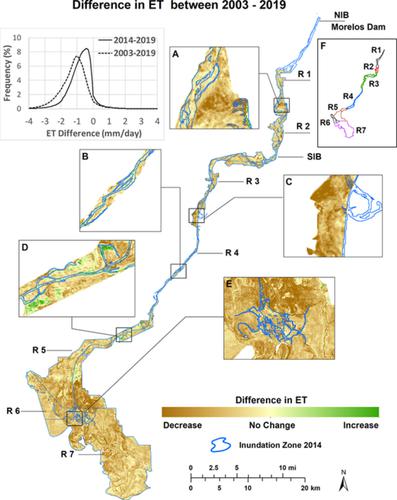当前位置:
X-MOL 学术
›
Hydrol. Process.
›
论文详情
Our official English website, www.x-mol.net, welcomes your
feedback! (Note: you will need to create a separate account there.)
Ecohydrological responses to surface flow across borders: Two decades of changes in vegetation greenness and water use in the riparian corridor of the Colorado River delta
Hydrological Processes ( IF 2.8 ) Pub Date : 2020-09-19 , DOI: 10.1002/hyp.13911 Pamela L. Nagler 1 , Armando Barreto‐Muñoz 2 , Sattar Chavoshi Borujeni 3 , Christopher J. Jarchow 2 , Martha M. Gómez‐Sapiens 4 , Hamideh Nouri 5 , Stefanie M. Herrmann 2 , Kamel Didan 2
Hydrological Processes ( IF 2.8 ) Pub Date : 2020-09-19 , DOI: 10.1002/hyp.13911 Pamela L. Nagler 1 , Armando Barreto‐Muñoz 2 , Sattar Chavoshi Borujeni 3 , Christopher J. Jarchow 2 , Martha M. Gómez‐Sapiens 4 , Hamideh Nouri 5 , Stefanie M. Herrmann 2 , Kamel Didan 2
Affiliation

|
Hydrological and bioclimatic processes that lead to drought may stress plants and wildlife, restructure plant community type and architecture, increase monotypic stands and bare soils, facilitate the invasion of non‐native plant species and accelerate soil erosion. Our study focuses on the impact of a paucity of Colorado River surface flows from the United States (U.S.) to Mexico. We measured change in riparian plant greenness and water use over the past two decades using remotely sensed measurements of vegetation index (VI), evapotranspiration (ET) and a new annualized phenology assessment metric (PAM) for ET. We measure these long‐term (2000–2019) metrics and their short‐term (2014–2019) response to an environmental pulse flow in 2014, as prescribed under Minute 319 of the 1944 Water Treaty between the two nations. In subsequent years, small‐directed flows were provided to restoration areas under Minute 323. We use 250 m MODIS and 30 m Landsat imagery to evaluate three vegetation indices (NDVI, EVI, EVI2). We select EVI2 to parameterize an optical‐based ET algorithm and test the relationship between ET from Landsat and MODIS by regression approaches. Our analyses show significant decreases in VIs and ET for both the 20‐year and post‐pulse 5‐year periods. Over the last 20 years, EVI Landsat declined 34% (30% by EVIMODIS) and ETLandsat‐EVI declined 38% (27% by ETMODIS‐EVI), overall ca. 1.61 mm/day or 476 mm/year drop in ET; using PAM ETLandsat‐EVI the drop was from 1130 to 654 mm/year. Over the 5 years since the 2014 pulse flow, EVILandsat declined 20% (13% by EVIMODIS) and ETLandsat‐EVI declined 23% (4% by ETMODIS‐EVI) with a 0.77 mm/day or a 209 mm/year 5‐year drop in ET; using PAM ETLandsat‐EVI the drop was from 863 to 654 mm/year. Data and change maps show the pulse flow contributed enough water to slow the rate of loss, but only for the very short‐term (1–2 years). These findings are critically important as they suggest further deterioration of biodiversity, wildlife habitat and key ecosystem services due to anthropogenic diversions of water in the U.S. and Mexico and from land clearing, fires and plant‐related drought which affect hydrological processes.
中文翻译:

跨境地表水的生态水文响应:科罗拉多河三角洲沿岸走廊的植被绿色度和用水量变化了二十年
导致干旱的水文和生物气候过程可能给植物和野生生物造成压力,改变植物群落的类型和结构,增加单型林分和裸露的土壤,促进非本土植物物种的入侵并加速土壤侵蚀。我们的研究重点是从美国(US)到墨西哥的科罗拉多河地表水量很少的影响。我们使用遥感测量的植被指数(VI),蒸散量(ET)和新的ET年度物候评估指标(PAM)来测量过去20年里河岸植物绿色度和用水量的变化。根据两国之间1944年《水条约》第319分钟的规定,我们测量了这些长期(2000-2019)指标及其对2014年环境脉动的短期(2014-2019)响应。在随后的几年中,在323分钟下向修复区提供了小方向的流量。我们使用250 m MODIS和30 m Landsat影像来评估三个植被指数(NDVI,EVI,EVI2)。我们选择EVI2来参数化基于光学的ET算法,并通过回归方法测试Landsat的ET与MODIS之间的关系。我们的分析表明,在20年和脉冲后5年期间,VI和ET均显着下降。在过去的20年中,EVI 我们的分析表明,在20年和脉冲后5年期间,VI和ET均显着下降。在过去的20年中,EVI 我们的分析表明,在20年和脉冲后5年期间,VI和ET均显着下降。在过去的20年中,EVI总体而言,Landsat下降了34%(EVI MODIS为30%),而ET Landsat-EVI下降了38%(ET MODIS-EVI为27%)。ET下降1.61毫米/天或476毫米/年; 使用PAM ET Landsat-EVI,下降幅度为1130至654毫米/年。自2014年脉冲流量以来的5年中,EVI Landsat下降了20%(EVI MODIS下降了13%),而ET Landsat-EVI下降了23%(ET MODIS-EVI下降了4%),为0.77 mm /天或209 mm / ET连续5年下降;使用PAM ET Landsat-EVI下降幅度为863至654毫米/年。数据和变化图显示,脉冲流贡献了足够的水以减慢损失速度,但仅在非常短的时间内(1-2年)。这些发现至关重要,因为它们表明,由于美国和墨西哥的人为水转移以及影响水文过程的土地清理,火灾和与植物有关的干旱,生物多样性,野生生物栖息地和关键生态系统服务进一步恶化。
更新日期:2020-09-19
中文翻译:

跨境地表水的生态水文响应:科罗拉多河三角洲沿岸走廊的植被绿色度和用水量变化了二十年
导致干旱的水文和生物气候过程可能给植物和野生生物造成压力,改变植物群落的类型和结构,增加单型林分和裸露的土壤,促进非本土植物物种的入侵并加速土壤侵蚀。我们的研究重点是从美国(US)到墨西哥的科罗拉多河地表水量很少的影响。我们使用遥感测量的植被指数(VI),蒸散量(ET)和新的ET年度物候评估指标(PAM)来测量过去20年里河岸植物绿色度和用水量的变化。根据两国之间1944年《水条约》第319分钟的规定,我们测量了这些长期(2000-2019)指标及其对2014年环境脉动的短期(2014-2019)响应。在随后的几年中,在323分钟下向修复区提供了小方向的流量。我们使用250 m MODIS和30 m Landsat影像来评估三个植被指数(NDVI,EVI,EVI2)。我们选择EVI2来参数化基于光学的ET算法,并通过回归方法测试Landsat的ET与MODIS之间的关系。我们的分析表明,在20年和脉冲后5年期间,VI和ET均显着下降。在过去的20年中,EVI 我们的分析表明,在20年和脉冲后5年期间,VI和ET均显着下降。在过去的20年中,EVI 我们的分析表明,在20年和脉冲后5年期间,VI和ET均显着下降。在过去的20年中,EVI总体而言,Landsat下降了34%(EVI MODIS为30%),而ET Landsat-EVI下降了38%(ET MODIS-EVI为27%)。ET下降1.61毫米/天或476毫米/年; 使用PAM ET Landsat-EVI,下降幅度为1130至654毫米/年。自2014年脉冲流量以来的5年中,EVI Landsat下降了20%(EVI MODIS下降了13%),而ET Landsat-EVI下降了23%(ET MODIS-EVI下降了4%),为0.77 mm /天或209 mm / ET连续5年下降;使用PAM ET Landsat-EVI下降幅度为863至654毫米/年。数据和变化图显示,脉冲流贡献了足够的水以减慢损失速度,但仅在非常短的时间内(1-2年)。这些发现至关重要,因为它们表明,由于美国和墨西哥的人为水转移以及影响水文过程的土地清理,火灾和与植物有关的干旱,生物多样性,野生生物栖息地和关键生态系统服务进一步恶化。











































 京公网安备 11010802027423号
京公网安备 11010802027423号